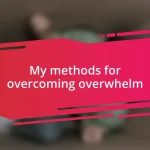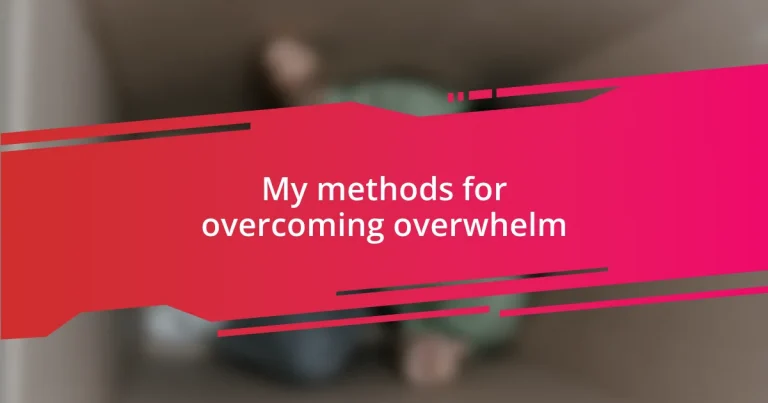Key takeaways:
- Identifying overwhelm triggers, such as feeling unprepared and societal pressures, is crucial for developing effective management strategies.
- Implementing time management techniques, like prioritizing tasks and time blocking, significantly improves productivity and reduces anxiety.
- Creating a supportive environment and practicing mindfulness and gratitude helps foster emotional balance and resilience in facing life’s challenges.
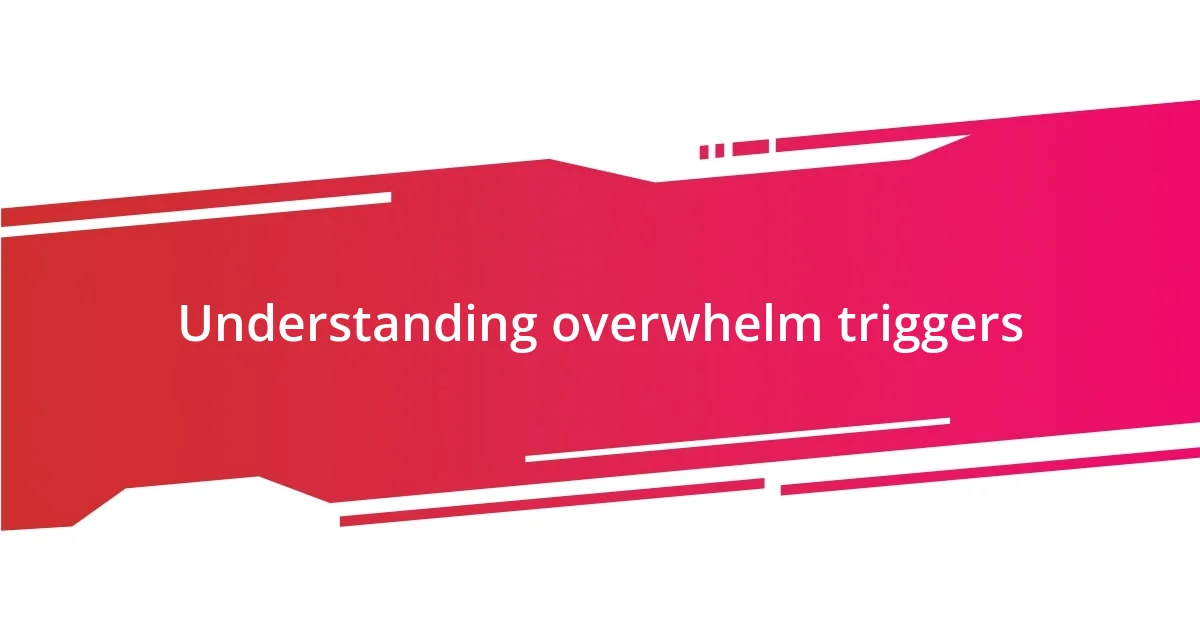
Understanding overwhelm triggers
Overwhelm often creeps in when I find myself juggling multiple deadlines, family commitments, and personal projects all at once. I remember a time when I had three work presentations due in one week while planning my daughter’s birthday party. The sheer weight of those responsibilities made me question, “How did I let it get to this point?” Recognizing that it wasn’t just the tasks themselves but the cumulative pressure of expectations was a turning point for me.
One of my biggest triggers is the feeling of being unprepared. The night before an important presentation, I often find myself doubting my capabilities, casting a shadow over my confidence. This internal dialogue spirals into a feeling of dread that can be paralyzing. Reflecting on these experiences made me realize the importance of preparation and self-affirmation to counteract those thoughts.
Social expectations can also ramp up feelings of overwhelm. Occasionally, I feel burdened by the pressure to socialize or network, especially when I’m mentally drained. I often ask myself, “Shouldn’t I want to engage with others?” but deep down, I’ve learned to accept that it’s okay to set boundaries. Understanding these triggers helps me develop strategies to manage them effectively, allowing me to take back control of my emotional landscape.
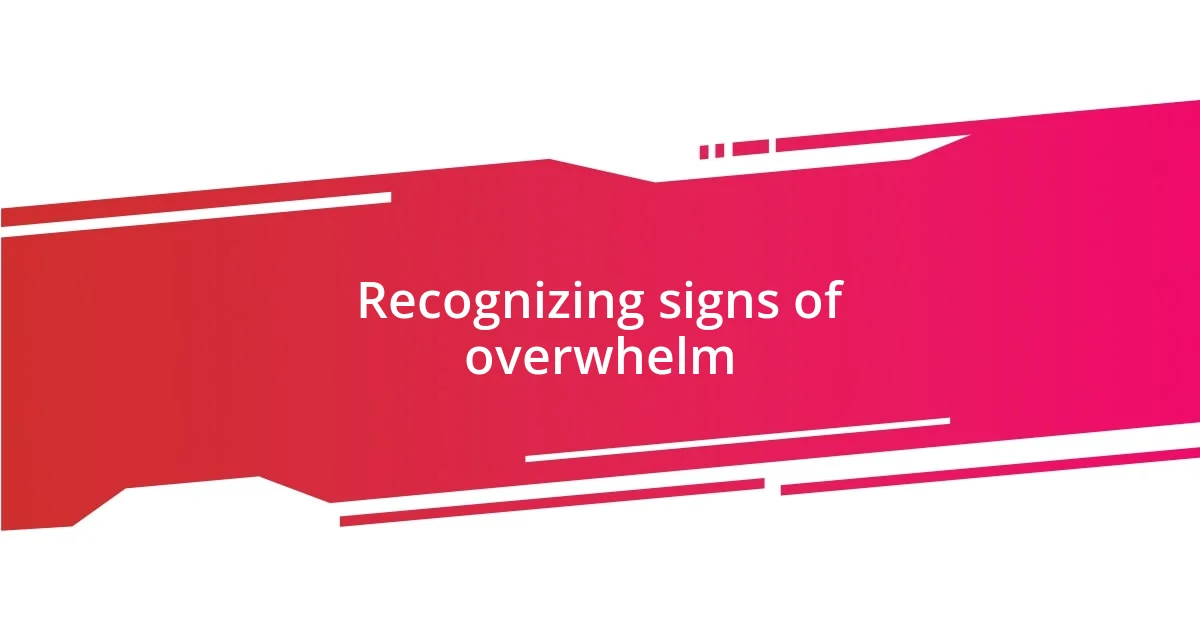
Recognizing signs of overwhelm
When I start feeling unusually fatigued or find it hard to concentrate, it’s often a signal that overwhelm is creeping in. I recall a time when I spent an entire day in front of my laptop, only to realize I had done little but scroll through emails. That foggy feeling can mask real fatigue, making it challenging to differentiate between needing rest and feeling stressed out.
Another sign I’ve learned to recognize is irritability. Simple things can become triggers; a misplaced item or a minor disagreement can set off a wave of frustration. It’s like an emotional temperature gauge for me. I’ve noticed that when I’m overwhelmed, my patience wears thin, and even the smallest annoyances can send my mood spiraling. Understanding this feeling prompts me to pause and reflect, which often helps in preventing a blow-up.
Physical symptoms can also accompany overwhelm, manifesting as headaches or tight knots in my shoulders. I remember a particularly hectic week where I developed a tension headache that lingered for days. This taught me that my body often knows I’m overwhelmed even before my mind fully registers it. Paying attention to these signals has become crucial in my journey to maintain balance in my life.
| Signs of Overwhelm | Personal Experience |
|---|---|
| Fatigue | Feeling drained yet unproductive, like I spent hours on my laptop without actually achieving anything. |
| Irritability | Small annoyances escalate, and my patience diminishes, hinting at underlying stress. |
| Physical Symptoms | Tension headaches and body aches emerge, revealing internal stress even before I acknowledge it. |
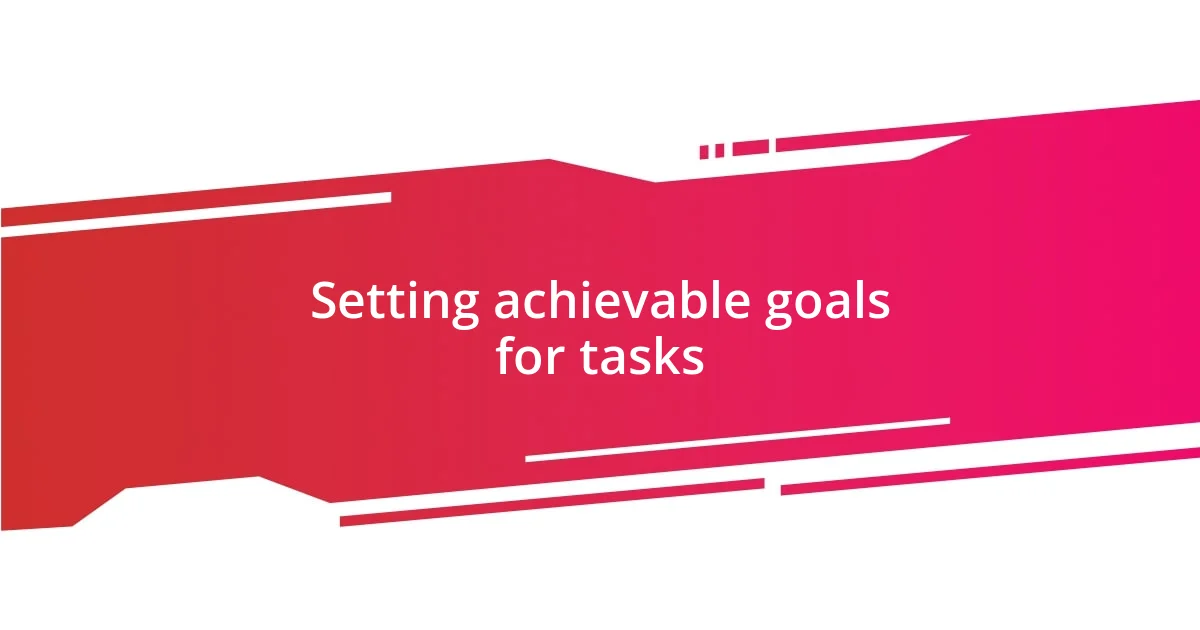
Setting achievable goals for tasks
Setting achievable goals for tasks
Setting achievable goals is vital for me to navigate tasks without feeling bogged down. I remember when I was preparing for a community event and felt the urge to do everything at once. Instead of diving in headfirst, I broke down my responsibilities into smaller, manageable goals. This shift not only diminished my stress but also allowed me to celebrate small wins along the way, making the entire process feel rewarding.
- **Prioritize tasks**: Identify what needs immediate attention and what can wait.
- **Set specific, measurable goals**: Instead of saying “I’ll work on my project,” I say “I’ll complete the first draft by Friday.” This clarity helps me stay focused.
- **Time block your activities**: I often allocate specific time slots for tasks, which helps me maintain momentum without feeling rushed.
- **Review and adjust regularly**: Each week, I reflect on my progress and make necessary adjustments. This practice keeps my goals realistic and achievable.
When I learned to set deadlines not just for entire projects but for each tiny component, I felt an immense weight lift from my shoulders. For example, while planning last year’s holiday gathering, I created a checklist with set goals for shopping, cooking, and decorating. Staring at the tasks as a series of bite-sized pieces rather than one massive endeavor made it all feel less intimidating. I can’t emphasize enough how breaking things down turned what would typically be overwhelming into something manageable and even enjoyable.
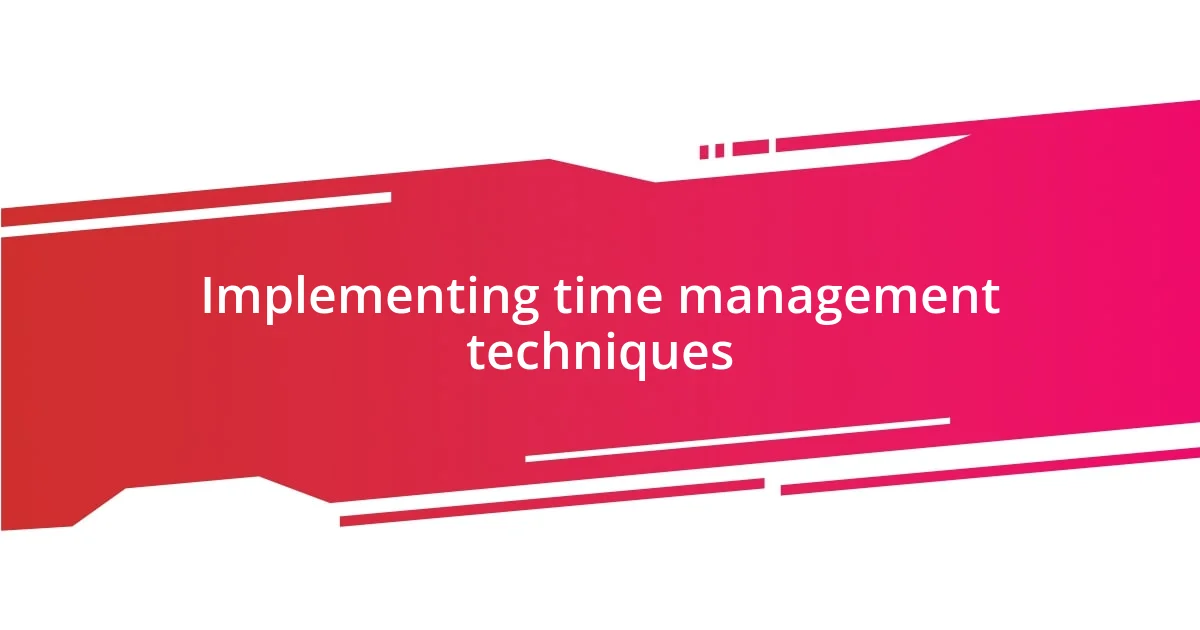
Implementing time management techniques
Implementing time management techniques has been a game changer for my productivity and peace of mind. One strategy I’ve embraced is prioritizing tasks based on urgency and importance. I remember a particularly busy week when I juggled work deadlines and personal commitments; rather than trying to tackle everything at once, I drafted a simple list, ranking tasks. This not only reduced my anxiety but also helped me focus on what genuinely needed my attention first. Have you ever felt that overwhelm just dissolves a little when you know exactly where to direct your energy?
Another powerful technique is time blocking. I often dedicate specific slots during my day to particular tasks. For instance, I reserve mornings for deep work when my mind is fresh and afternoons for less demanding activities, like responding to emails. There was a time when I tried to multitask, thinking I could be productive on multiple fronts simultaneously—only to end up spinning my wheels. Creating these blocks transformed my workflow and prevented that dreaded feeling of being everywhere and nowhere at once.
Regular reflection and adjustment of my goals has also made a significant difference. Each week, I take a moment to assess what I’ve accomplished and what needs tweaking. This practice doesn’t just keep me on track; it allows me to celebrate my progress, no matter how small. Can you recall a moment when pausing to reflect led to an unexpected revelation about your own habits? It certainly helped me realize that sometimes less is more, and that lightness makes the load much easier to carry.
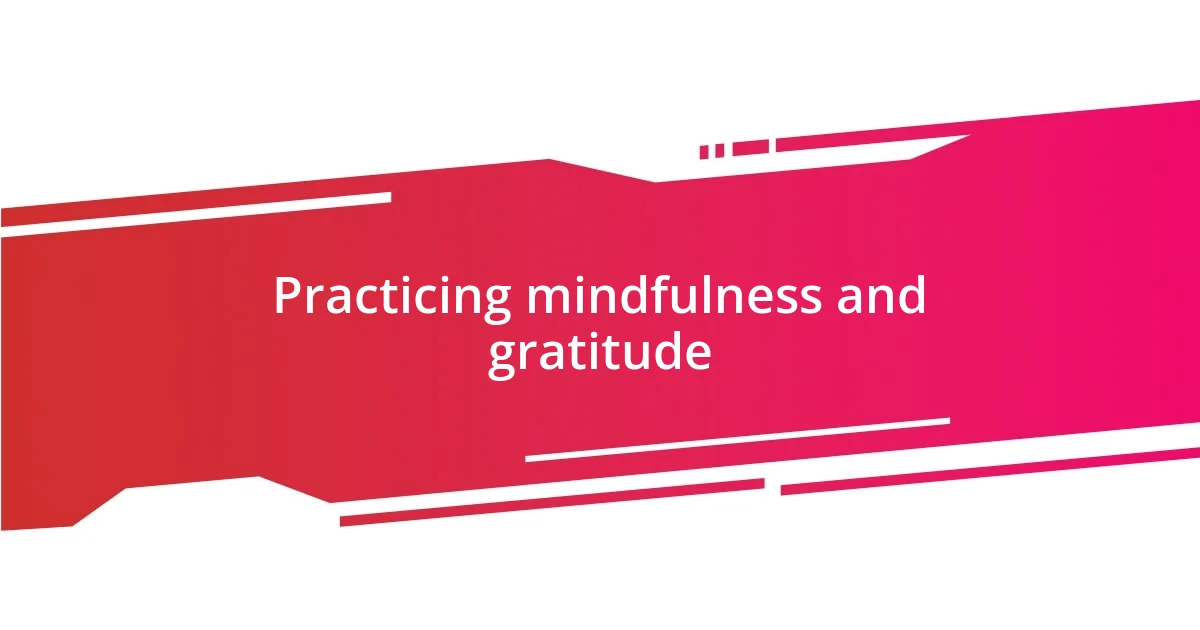
Practicing mindfulness and gratitude
Practicing mindfulness has truly transformed my approach to daily life. I often find myself pausing to take deep breaths, especially during chaotic moments. For instance, during a particularly hectic day at work, I stepped away for just five minutes to center myself, and it changed everything. That short break not only helped me regain clarity but also allowed me to return to my tasks with a refreshed mindset. Have you ever noticed how just a few moments of mindfulness can shift your entire day?
Incorporating gratitude into my routine has been just as impactful. I’ve started a simple practice of jotting down three things I’m thankful for each evening. This ritual has helped shift my focus from the stressors of the day to the small joys I sometimes overlook, like a warm cup of coffee or a thoughtful message from a friend. I once shared this practice with a friend who felt overwhelmed by life’s challenges—and it truly opened her eyes to the positivity surrounding her. Could a shift in perspective like this help you see the light in your own busy days?
Lastly, I’ve learned that combining mindfulness and gratitude can create a powerful tool against overwhelm. When I find myself feeling anxious, I take a moment to reflect on what I’m grateful for while being fully present in the moment. For example, during a family gathering that felt a bit chaotic, I paused to appreciate the laughter and connections around me. I can’t tell you how grounding that felt—transforming my anxiety into appreciation. Isn’t it fascinating how quickly our outlook can change when we anchor ourselves in gratitude?
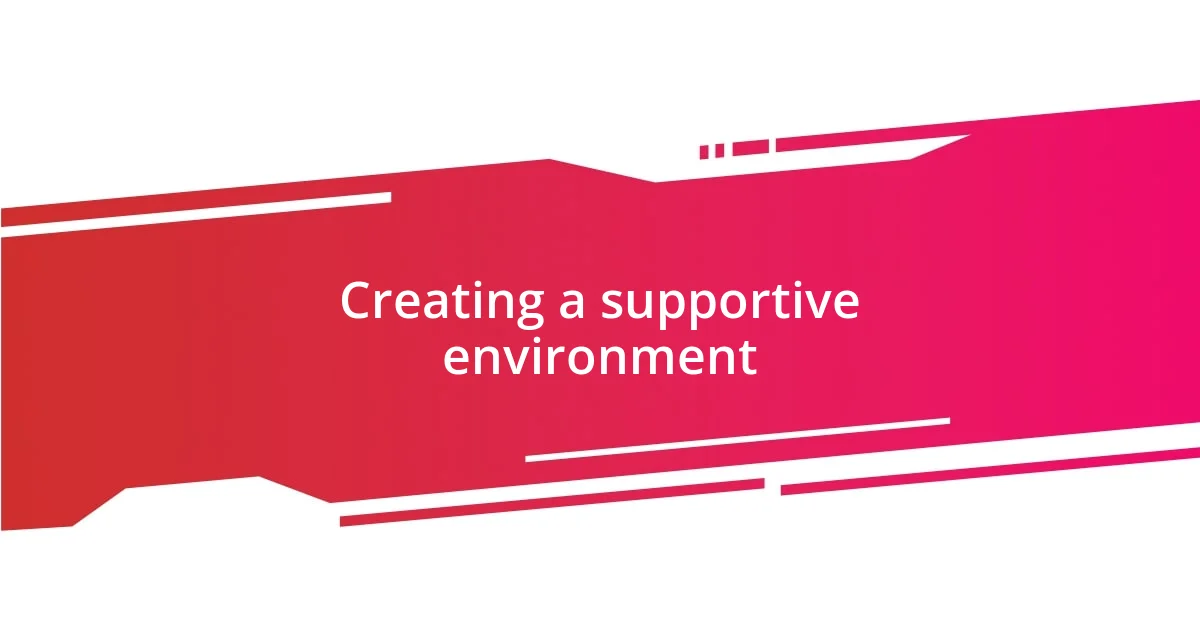
Creating a supportive environment
Creating a supportive environment has been pivotal in my journey to overcome overwhelm. It’s amazing how the physical space around us can impact our mental state. For example, I once revamped my home office; decluttering my workspace made an immediate difference. I remember feeling lighter and more focused, as if a weight had been lifted. Have you ever thought about how your surroundings influence your mood and productivity?
Another aspect I find crucial is surrounding myself with positive people. I’ve learned the importance of having supportive friends or mentors who uplift rather than drain my energy. One time, after sharing my struggles with a close friend, she not only listened but also offered practical solutions that I hadn’t considered. It was a reminder of how valuable it is to connect with those who empower and inspire us. How often do you assess whether your circle is adding to your sense of well-being or contributing to your overwhelm?
Additionally, setting boundaries in my environment has been transformative. I used to feel pressured to be available at all times, but I established clear work and personal hours, letting others know when I would be off the grid. By doing so, I created a sanctuary for myself—a space where I could recharge and focus without interruptions. I can’t stress enough how liberating it feels to protect your time. Could prioritizing your own needs lead to a more harmonious life? I believe it can, and I’ve seen the positive effects in my own experience.
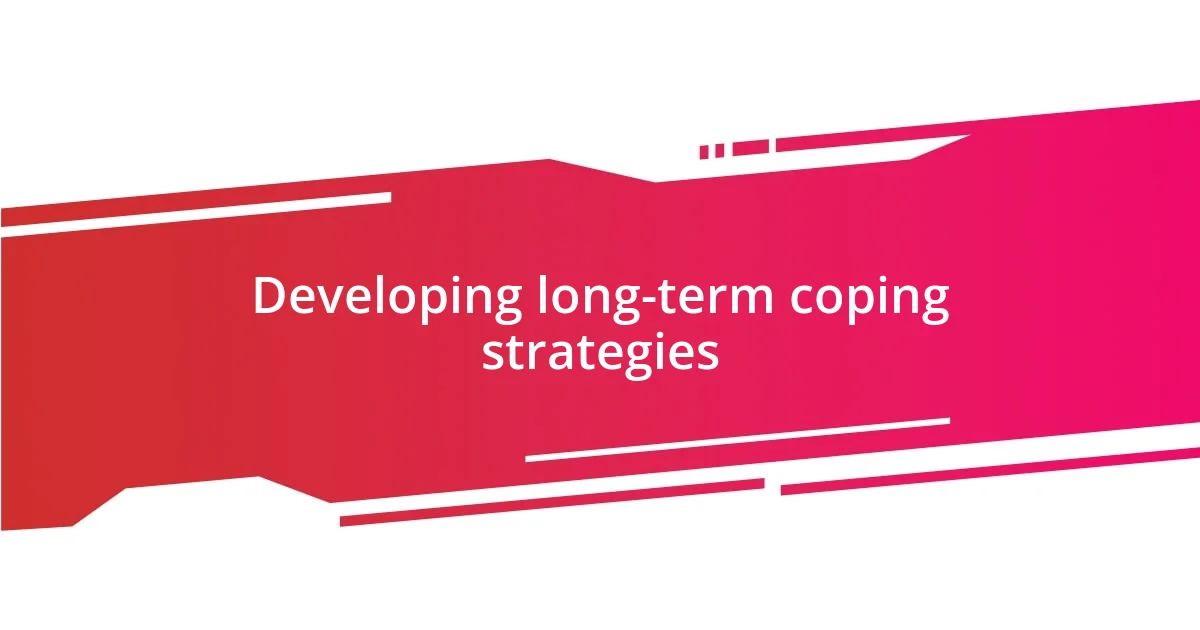
Developing long-term coping strategies
Developing long-term coping strategies is essential for maintaining emotional balance over time. One method I’ve found particularly useful is creating a structured routine. I remember when I transitioned to a more predictable daily schedule; it was like giving myself a comforting anchor. Having set times for work, meals, and relaxation not only reduces uncertainty but also makes it easier to prioritize self-care. Have you experienced how routine can foster a sense of security in your own life?
I also focus on fostering resilience through ongoing learning and self-reflection. After a challenging experience at work last year, I took the time to journal about what I learned and how I could apply those lessons moving forward. This reflective practice helped me recognize patterns in my responses to stress, enabling me to respond more proactively in the future. It’s intriguing to discover how much insight we can gain from simply looking back. Isn’t it powerful to turn challenges into stepping stones for growth?
Lastly, I can’t emphasize the importance of self-compassion enough. There was a time when I’d beat myself up for not meeting my own expectations, which only added to my feelings of overwhelm. By practicing self-kindness—like talking to myself as I would to a friend—I’ve learned to embrace my imperfections and celebrate small victories. This shift not only alleviated the pressure I imposed on myself but also fostered a more positive mindset. Could nurturing a kinder inner voice be the secret ingredient to your long-term well-being?








